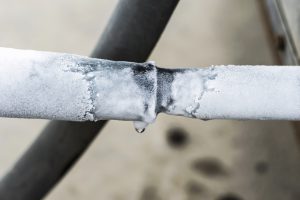Picture this: You’ve just come back from a winter vacation in Cabo. You’ve got a tan, you’re relaxed, and life is good. You step into your home, unpack your clothes, and start drawing a bath — except when you do, the water barely trickles out of the faucet. Great. You try the bathroom sink, and it’s the same issue. What’s going on?
In a scenario like this, the culprit could be a frozen pipe. This issue is something familiar to anyone living in an area with cold winters — just like Denverites!
Frozen pipes are a relatively common plumbing issue during the winter months, but homeowners can take steps to reduce or even eliminate the risk. We’ll give you our top tips on how to keep pipes from freezing below, but first, let’s look at the symptoms you might encounter in your home.
How To Diagnose Frozen Pipes
Frozen pipes can cause various issues, which makes it easy for someone to mistake them for another plumbing issue. A trained plumber can quickly diagnose and repair any issue you experience. When in doubt, give us a call!
Signs That Indicate The Presence Of Frozen Pipes
The first issue you’ll likely notice is inconsistent water flow to your appliances or from taps and faucets. Pipes get clogged by ice and slush. If the clog is too severe or the water pressure is too low to clear the ice, you’ll see little to no water flow. You may also see an inconsistent or sputtering flow from some faucets. This kind of operation is common if the pipes aren’t fully frozen or enough pressure to clear blockages is present.
If your pipes are severely frozen, you’ll likely be able to tell when you inspect them. They often become covered in frost or ice as water condenses then freezes on their surface. You can check pipes beneath your sink or from anywhere your lines may be visible in your home: the utility closet or basement, for instance.

Another sign of frozen pipes is inconsistent water temperature. If you try to take a shower and the water doesn’t seem to warm up quickly enough (or at all), you may have a frozen pipe.
Occasionally, flushing toilets or running water produces strange noises, such as bubbling, whistling, gurgling, or rattling. These noises are often signs that indicate a frozen pipe. In some cases, frozen pipes may cause backups in your system, causing odors to waft from open drains.
Finally, damp drywall or puddles forming near pipes in your home can indicate a leaking or burst pipe, which could be caused by freezing.
Pipes nearest to the exterior walls of your home or in attics and basements are most likely to freeze. Check these areas first if you suspect frozen pipes.
What Do I Do?
If you find that your pipes froze, the first thing you should do is call a plumber. Unless you have experience working with plumbing systems, you could end up inadvertently making the issue worse by trying to fix it! A plumber can diagnose the extent of damage to your system and safely fix the problem. When it comes to the integrity and safety of your home, don’t take a risk.
If the issue is not severe, there are some ways to help thaw your pipes safely. If the line is easy to access, you could use a hairdryer, space heater, or another source of gentle heat to melt it slowly. Never use a blowtorch or other source of open flame or intense heat to thaw a pipe. Not only is this dangerous, but it may cause more damage to your pipes than the freezing has already done.
If you cannot reach a pipe — for instance, if your lines lie hidden behind your drywall — you can try thawing it with ambient heat. Turn up your thermostat by a few degrees, and the pipe may eventually thaw. We don’t recommend doing this unless advised by your plumber. If the pipe in your wall has burst without your knowledge, you could cause water damage and flooding in your home. You may want to shut your water line off temporarily as you attempt to thaw your pipes. This action will ensure that any water damage is minimal and will reduce pressure in your plumbing.
How to Keep Pipes from Freezing
As the saying goes, an ounce of prevention is worth a pound of cure. Let’s take a look at how to prevent frozen pipes.
The most common time that pipes freeze is when you’re away during the winter. When you’re away, your pipes sit unused. The water in your system isn’t flowing, which increases the likelihood that it will ice up. Furthermore, most people turn the thermostat down (or even turn their furnace off) when they leave for an extended trip. This alteration also increases the chances your pipes may freeze by lowering the ambient temperature of your home.
You can significantly reduce the risk of pipes freezing while traveling by shutting off your water supply before you leave. If frozen pipes have been an issue for you in the past, you may also consider installing additional insulation around problem areas. There are many products available specifically for heating or insulating pipes. Our plumbers can help you select the right option for your home.
Which Homes Are Susceptible to Frozen Pipes?
Homes with outdoor plumbing fixtures such as faucets for garden hoses and underground sprinkler systems should drain their systems or have them blown out by a professional as needed each Fall. Be sure to leave the valve open for outdoor faucets. This open valve will allow any remaining water room to expand within the faucet. Otherwise, the remaining water may freeze, damaging the faucet.
Older homes may be particularly susceptible to frozen and burst pipes due to poor insulation or poor plumbing system layout. If frozen pipes seem to be an issue for you each year, you might consider renovating your home to improve insulation or redirect problem pipes away from areas exposed to cold.
Frozen pipes are an issue that many homeowners face each winter. Fortunately, there are steps you can take to prevent the problem altogether. You can avoid costly repairs in the future with a bit of preventative maintenance.
Check out some of our related plumbing tips!
What is a P-Trap, and why is it an essential part of your plumbing


